Replacing earthworm by water spinach or duckweed on growing frogs with basal
diet of rice bran and broken rice
Chhay Ty, Ung Ratha, Vor Sina, Khieu Borin and T R
Preston*
Center for Livestock and Agriculture Development (CelAgrid).
Pras Teat village, Rolous commune, Kandal Stung district, Kandal province.
PO Box 2423 Phnom Penh 3, Cambodia
chhayty@celagrid.org
* Fundación para la Producción Agropecuaria Tropical Sostenible Capitulo
Colombia
Abstract
The aim of the
experiment was to study on replacing earthworm by water spinach or duckweed on
growing frogs with basal diet of rice bran and broken rice in 18 ponds with area
of 2 m2
(2m x 1m) and 0.4m deep in each pond. All ponds were lined with white plastic in
order to avoid filtration of water. A total of 144 frogs were bought from farmer
and adapted to experimental area and feed for 10-15 days before started
experiment. Frog stocking densities were 4 frogs per m2. The
experiment design was Completely Randomized Design (CRD) with 3*2 factorial
arrangements of 6 treatments and three replications within each treatment, the
first factor was protein sources from earthworm (EW) alone, duckweed mix with
earthworm (DW-EW) or water spinach mix with earthworm(WS-EW) and second factor
was with or without light supplementation at night. In overall, the
DM feed offer and CP offer were not different of DW-EW
and EW but lowest was found in WS-EW treatment (P<0.001). DM feed offer and CP
offer were high when light was supplement rather than without light
supplementation. The live weight gain were found the best in all period of
experiments when the frogs fed EW diet rather than WS-EW or DW-EW treatment
(P<0.05). Supplementing light was effect on live weight gain compared with
without light supplementation (P<0.05) but accepted from 30-60 days (P>0.05).
The feed conversion ratio in DM basis was better on DW-EW and EW alone and
poorest was WS-EW treatment (P<0.001), while the light supplementation was not
effect (P>0.05) but excepted period of 60-90 days, feed conversion ratio were
better on light supplementation (P<0.05). The survival rate and net yields were
highest on earthworm treatment and not different in mixture of DW-EW and WS-EW.
Light supplementation was effect on high survival rate and yield compared with
without light supplementation. It can concluded that growth rates, survival and
yield were best on treatment earthworm alone and light supplementation, while
the mixture of duckweed with earthworm were improved but poorest was water
spinach mix with earthworm.
Key
words: earthworm, water spinach, duckweed, light, live weight, survival, yield
Introduction
Frog meat are important for
human consumption and it is more economic in some countries such as France,
Japan, Germany, Singapore, Hong Kong, Singapore and Malaysia (Akasay, 1994). In
Cambodia, Many consumers are preferring frog meat, event in restaurant; they
preserved frog food because frog meat can make much kind of foods and good taste
and most of the frog come from the natural. However, in Cambodia, the
cultivation of frogs is still not attractive because of farmers don’t know how
to rise or how to fed to that animal. In recently, Care international in
Cambodia has introduce frog raising to farmer as pilot activities in Pailin
province but farmers fed mix concentrate feed with rice bran which is not
economic retune. However, there are other alternative feed which farmers can use
as protein sources such as earth worm, water spinach, duckweed and energy
sources come from by product such as rice bran, broken rice etc.
Earthworms are appropriate
elements in systems of recycling livestock manure and have high in protein
(59.9%), dry matter (15-20%), crude fiber (7.43%), Ca (1.73%) and P (0.118%)
(Bay, 2002). Earthworm meal has been used for poultry, chicken and fish in diets
because it can substitute for fishmeal in diets (Bay 2002). The studies had done
in India (Kale et al., 1982) and Guerro, 1983) shown that earthworm have
successfully converted animal manure into a good source of protein as
supplementary in the diet for animal and the weight gain of Tilapia was higher
when given a diet with a supplement of earthworm than when given a fish meal
supplement. The study by Nguyen Duy Quynh Tram et al., (2007) on growing
catfish fed a diet containing 30% CP from trash fish as control diet and with
the CP from trash fish replace by earthworm of 25, 50, 75 and 100% showed that
weight gain, daily weight gain, FCR and specific growth rate were highest for
earthworm 75% at 41.3 g, 0.69g/day, 1.53 g, feed/g gain and 4.5%/day
respectively and the lowest growth parameter were in treatment without
earthworm. However, the study using earthworm for frog is little study.
Water spinach is available
naturally in the rainy season or it can be planted in the rainy and dry seasons.
The two types of water spinach; land and aquatic, are commonly cultivated by
farmers. When water is not a constraint factor, aquatic water spinach has the
capacity to produce foliage for longer period. Aquatic water spinach produces up
to 40 ha-1 cut-1 when applied 200 kg of nitrogen ha-1
year-1 (CelAgrid, unpublished data). Beside high yield, water spinach
have high protein 27.1% and have been use for feeding pig and growth rate were
respond with level of water spinach in the diets (chhayty et al
2005ab,2006,2007).
Other protein source is
duckweed, it can growth well in waste water and protein are variable depend on
fertilizer and rang from 35-40% in the dry matter (Leng et al 1995; Rodriguez
and Preston 1996; Nguyen Duc Anh et al 1997; Le Ha Chau 1998). The balance of
essential amino acids in duckweed is considered to be comparable to that in soy
bean meal (Muztar et al 1976; Rusoff et al 1980). The protein in duckweed is
more digestible than in cassava leaves (Nguyen Van Lai and Rodriguez 1998).
The aims of the present study
is using earthworm, water spinach and duckweed as protein sources for growing
frogs with basal diet of rice bran and broken rice
Materials and methods
Location
The experiment was carried out
at the Center for Livestock and Agriculture Development (CelAgrid), located in
Preah Theat village, Sankat Rolous, Khan Dangkor about 25km from Phnom Penh
City, Cambodia during rainy season from 05th July to 03rd
October 2011.
Ponds preparation
A total of 18 ponds were organized
under tree and without roof with area of 2 m2 (2m x 1m) and 0.4m deep
in each pond. All ponds were lined with white plastic in order to avoid
filtration of water. Small wood post each 1 m high was erect at the four corners
of each pond and a plastic net were placed around the poles to make a fence for
the pond. Electric light were connected at night on the surface of the pond
(0.8m high) for light supplementation treatment, while without light
supplementation, plastic net were used to cover the surface of the pond in order
to avoid protein source (insect) at night.
Experimental frog
A total of 144 frogs were bought from a farmer’s farm in
Kandal province. All frogs were adapted to experimental area and feed for 10-15
days before started experiment. Frog stocking densities were 4 frogs per m2.
Experimental feed and feeding
The California earthworm and duckweed were cultured at
CelAgrid farm, while water spinach was purchased from farmers. Rice bran and
broken rice were purchased from local rice mill around the center. Water spinach
was chopped very small pices (about 0.5-1mm) before feeding to frogs, while
duckweed was wilted overnight before feeding. Earthworm after the harvesting was
chopped from 2-3cm and then mixing with other ingredients and very homogenized.
|
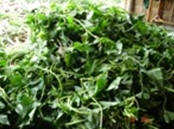
|
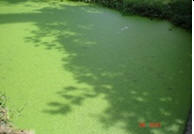
|
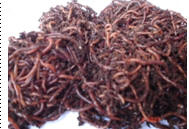
|
|
Picture 1:
Water spinach |
Picture 2:
Duckweed |
Picture 3:
California earth worm |
|
Table 1:
Chemical composition of the dietary ingredients used to formulated
the experimental diets in DM basis |
|
|
%Dry mater |
% Crude
protein |
|
Ingredients |
|
|
|
Duckweed |
8.51 |
30.9 |
|
Water spinach |
11.7 |
28.2 |
|
Earthworm |
20.0 |
60.9 |
|
Rice bran |
89.7 |
9.92 |
|
Broken rice |
88.1 |
8.84 |
|
Premix |
97.0 |
- |
|
Salt |
95.0 |
- |
The frogs were fed twice per day at 07.00 h and 18.00 h. All
feed ingredients were mixed together before feeding. The quantities were fixed
at 10% of the body weight. All experimental ingredients were mixed and very
homogenized. The experiment was conducted in the raining season during 90 days
of experiment.
|
Table 2:
Ingredients content and chemical composition of the experimental
diets |
|
|
Diets## |
|
EW |
WS-EW |
DW-EW |
|
Ingredients, % DM basis |
|
|
|
|
Earth worm |
41.5 |
20.0 |
21.0 |
|
Water spinach |
0.0 |
50.0 |
0.0 |
|
Duckweed |
0.0 |
0.0 |
51.0 |
|
Rice bran |
29.0 |
14.0 |
13.0 |
|
Broken rice |
28.0 |
14.5 |
13.5 |
|
Bio premix 17# |
1.0 |
1.0 |
1.0 |
|
Salt (NaCL) |
0.5 |
0.5 |
0.5 |
|
Total |
100.0 |
100.0 |
100.0 |
|
Analysis, %
in DM basic before starting experiment |
|
Dry matter |
60.4 |
36.6 |
33.5 |
|
Crude protein
(N*6.25) |
30.1 |
30.1 |
30.0 |
|
#Amount
per kg: Vitamin A: 2800000UI, Vitamin D3:
324000UI, Vitamin E: 2100UI, Vitamin B1: 240mg, Vitamin B2:
440mg, Vitamin B12: 3200mcg, Biotim: 4800mcg, Pantothenic
Acid: 2000mg, Fe: 25200mg, Cu: 14400mg, Zn: 37800mg, Mn: 10800mg, I:
252mg, Se: 216mg
EW: earthworm, DWEW: duckweed mix with earthworm, WSEW: water
spinach mix with earthworm
##
EW: Earth worm; WS-EW: Water
spinach mix with earth worm; DW-EW: Duckweed mix with earth worm
|
Experimental design
The experiment design was
Completely Randomized Design (CRD) with 3*2 factorial arrangements of 6
treatments and three replications within each treatment, the first factor was
protein sources from earthworm (EW) alone, duckweed mix with earthworm (DW-EW)
or water spinach mix with earthworm (WS-EW) and second factor was with or
without light supplementation at night.
Protein sources
- EW
: Earthworm + broken rice and rice bran
- DW-EW: Duckweed +
earthworm + broken rice and rice bran
- WS-EW: Water spinach
+ earthworm + broken rice and rice bran
Light supplement at night
Treatment combination
- Earthworm + broken rice +
rice bran and electric light suppmentation
- Duckweed + earthworm + +
broken rice + rice bran and electric light suppmentation
- Water spinach + earthworm
+ broken rice + rice bran and electric light suppmentation
- Earthworm + broken rice +
rice bran and without light suppmentation
- Duckweed + earthworm +
broken rice + rice bran and without light suppmentation
- Water spinach + earthworm
+ broken rice + rice bran and without light suppmentation
Measurements and chemical analysis
The amounts of feed offered
were recorded daily. All frogs/pond (8 heads) were weighed every 10 days during
the 90 days of the experiments. Individual daily weight gains were calculated by
the regression of live weight on time in days. Feed conversion ratio was
calculated from individual daily DM offer/intake and live weight gain.
Samples of ingredients such as
earthworm, duckweed, water spinach, rice bran and broken rice were taken for the
analysis of nitrogen, using a Foss-Tecatur
kjeldahl apparatus (AOAC 1990), and for dry matter
by oven (Undersander et al 1993).
The oxygen
level of the pond water was measured every week, two times at 7 am and at 2 pm.
“Winkler” test-kits (Aquamerck)
was used for the measurement. The pH of the pond water was also measured
every week, two times at 7 am and at 2 pm by glass
electrode. Water temperature was measured every week, three times a day in the
morning at 7 am, at 12 am and in the evening at 5 pm.
Statistical analysis
The data from feed offer, growth
rate, feed conversion, and yield and survival rate were analyzed by the General
Linear Model in the ANOVA option of the software in Minitab 2007 (version
15.1.2). Sources of variation were protein source, light supplementation and
interaction between protein source * light supplementation and error. When the
F-test was significant at P<0.05, pair wise comparisons were performed using
Turkey’s procedure (Minitab Statistical Software). The model used was:
Yij = μ + Ei + Lj
+ Ei*Lj + eijk
Where, Y = Dependent variable
μ = Overall mean
Ei = Protein sources effect
Lj = With or without light
supplementation effect
Ei*Lj = Interaction between
protein sources * light supplementation
eij = random error
Results and discussion
General
The experiment was conducted in
rainy season and we could not collected feed refusal because most of feed
refusals were flow to frog ponds. Most of feed refusals were broken rice, rice
bran and water plant (water spinach or duckweed) but earth worm were consume
quickly by frog and no refusal.
|
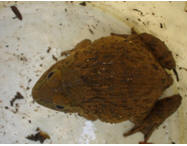 |
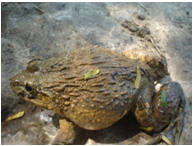 |
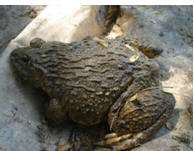 |
|
Picture 4:
Frog fed duckweed |
Picture 5:
Frog fed water spinach |
Picture 6:
Frog fed earthworm |
Feed offer
Total feed offer in fresh basis
were high on the mixture DW-EW, then WS-EW and the lowest was EW treatment alone
(P<0.001), while offer in DM basis were not different of DW-EW and EW but lowest
was found in WS-EW treatment (P<0.001), meanwhile, crude protein offer was high
for EW, then DW-EW and lowest was WS-EW (P<0.001). In term of light
supplementation was higher than without light supplementation. The different in
feed offer could be effect by different on live body weight during the periods
of experiment. A recommendation by LARReC, (2001) reported that the lowland frog
require similar nutrients as other aquatic animal species, especially those that
are carnivorous, to maintain normal growth and metabolic function. The major
nutrients such as protein, lipids, essential fatty acids, carbohydrates,
vitamins and minerals are required for normal growth. A study by Thongyount
(2004) reported that tadpoles from 1-30 days require protein at 38% in DM and
reduce to 32% for small frogs (30-60 days) and 26% for fattening frog (60-90
days). Artificial feed of 35 % crude protein supported faster growth in Rana
pipen tadpoles than young tilapia fish of 23 % protein (Ling et al., 2003).
According to Martinez et al., (1993) mention that commercial feeds with 39%
protein feed is suitable for frogs in intensive culture. Somsueb and
Boonyaratpalin (2001) also reported that the optimum protein content of diets
for raising frogs intensively is 37% in DM. Protein recommendations above are
ranged in present study which balance of 30% in DM basic in three diets,
however, it was lower than study of Latsamy Phounvisouk and Preston (2007) who
use 53.5-55.1% in DM basic in the diets but the high value because of they used
only earthworm alone or earthworm (90.2% in the diets DM basis) mixture with
fresh duckweed (9.76% in the diets in DM basis).
|
Table 3:
Mean value of feed offer of frog fed earthworm (EW) or duckweed mix
with earth worm (DW-EW) or water spinach mix with earthworm (WS-EW)
with basal diet of rice bran and broken rice |
|
|
Protein sources |
Light
supplementation |
|
DW-EW |
EW |
WS-EW |
SEM |
Prob |
With |
Without |
SEM |
Prob |
|
Feed offer
in fresh basis, g/day |
|
|
|
|
|
|
|
Broken rice |
11.6 |
30.8 |
10.4 |
0.49 |
0.001 |
19.1 |
16.1 |
0.40 |
<0.001 |
|
Rice bran |
11.0 |
31.3 |
9.89 |
0.49 |
0.001 |
18.9 |
16.0 |
0.41 |
0.001 |
|
Earthworm |
79.7 |
201.1 |
63.4 |
3.22 |
0.001 |
124.4 |
105.1 |
2.64 |
0.001 |
|
Water spinach |
0 |
0 |
272.0 |
3.89 |
0.001 |
100.4 |
81.0 |
3.18 |
0.001 |
|
Duckweed |
454.8 |
0 |
0 |
6.16 |
0.001 |
169.6 |
133.5 |
5.03 |
0.001 |
|
Premix |
0.78 |
0.99 |
0.65 |
0.02 |
0.001 |
0.89 |
0.74 |
0.01 |
0.001 |
|
Salt |
0.39 |
0.51 |
0.33 |
0.01 |
0.001 |
0.45 |
0.38 |
0.08 |
0.001 |
|
Total per pond |
558.2a |
264.7b |
356.7c |
9.89 |
0.001 |
433.7 |
352.8 |
8.08 |
0.001 |
|
Total per head |
69.8a |
33.1b |
44.6c |
1.24 |
0.001 |
54.2 |
44.1 |
1.01 |
0.001 |
|
Feed offer
in DM basis, g/day |
|
|
|
|
|
|
|
|
Broken rice |
10.2 |
27.1 |
9.19 |
0.44 |
0.001 |
16.8 |
14.2 |
0.36 |
0.001 |
|
Rice bran |
9.87 |
28.1 |
8.87 |
0.44 |
0.001 |
16.9 |
14.3 |
0.36 |
0.001 |
|
Earthworm |
15.9 |
40.2 |
12.7 |
0.65 |
0.001 |
24.9 |
21.0 |
0.53 |
0.001 |
|
Water spinach |
0 |
0 |
31.7 |
0.45 |
0.001 |
11.7 |
9.43 |
0.37 |
0.001 |
|
Duckweed |
38.7 |
0 |
0 |
0.52 |
0.001 |
14.4 |
11.4 |
0.43 |
0.001 |
|
Premix |
0.76 |
0.97 |
0.63 |
0.02 |
0.001 |
0.86 |
0.71 |
0.01 |
0.001 |
|
Salt |
0.38 |
0.49 |
0.32 |
0.09 |
0.001 |
0.43 |
0.36 |
0.08 |
0.001 |
|
Total per pond |
65.6a |
69.8a |
54.2b |
1.55 |
0.001 |
69.2 |
57.2 |
1.27 |
0.001 |
|
Total per head |
8.21a |
8.72a |
6.77b |
0.19 |
0.001 |
8.65 |
7.15 |
0.15 |
0.001 |
|
Crude
protein offer in DM basis, g/day |
|
|
|
|
|
|
|
Broken rice |
0.86 |
2.29 |
0.76 |
0.03 |
0.001 |
1.42 |
1.20 |
0.03 |
0.001 |
|
Rice bran |
0.98 |
2.79 |
0.88 |
0.04 |
0.001 |
1.68 |
1.42 |
0.03 |
0.001 |
|
Earthworm |
9.77 |
24.7 |
7.78 |
0.40 |
0.001 |
15.3 |
12.9 |
0.32 |
0.001 |
|
Water spinach |
0 |
0 |
9.01 |
0.13 |
0.001 |
3.32 |
2.68 |
0.10 |
0.001 |
|
Duckweed |
12.2 |
0 |
0 |
0.18 |
0.001 |
4.56 |
3.59 |
0.14 |
0.001 |
|
Total per pond |
23.8a |
29.7b |
18.4c |
0.61 |
0.001 |
26.2 |
21.8 |
0.49 |
0.001 |
|
Total per head |
2.98a |
3.72b |
2.31c |
0.07 |
0.001 |
3.28 |
2.30 |
0.06 |
0.001 |
|
abc
Means within main effects within rows without common letter are
different at P<0.05 |
Weight
gain and feed conversion ratio
The live weight gain (LWG) were
found the best in all period of experiments when the frogs fed EW diet rather
than WS-EW or DW-EW treatment (P<0.05), by the ways, light supplementation at
night also effect on LWG compared with without light supplementation treatment
(P<0.05) but excepted from 30-60 days (P>0.05). Latsamy Phounvisouk and Preston
(2007) study on fly larvae, earthworms and duckweed as feeds for frogs in an
integrated farming system showed that daily LWG was 2.10g when the frogs fed
only earthworm alone (100% in DM basis) but daily LWG was increased to 2.80g
when the frogs fed earthworm (90.2% in the diet, DM basis) mixed with fresh
duckweed (9.76% in the diets, DM basis). The report was contracted with present
study which showed that LWG was high in earthworm (2.62g/day) treatment compared
with earthworm mix with duckweed (1.91g/day) treatment and by the ways,
earthworm that used in present study was lower level (20-40% in the diets, DM
basis) and balance of crude protein in the diets (30% in DM) compared with
Latsamy Phounvisouk and Preston (2007) used high amount of earthworm (90-100% in
the diets, DM basis) and high crude protein in the diets (53.5-55.1%, DM basis).
Other possible of contraction with daily weigh gain of study of Latsamy
Phounvisouk and Preston (2007) could be escape of some earthworm to the pond,
while the present study, earthworm were chopped and mixed with other
ingredients. The present study showed growth rate much higher (2.62g/day) than
study on catfish (0.69g/day) given diets containing rice bran (60%), trash fish
(10%) and earthworms (30%) (Nguyen Duy Quynh Tram et al., 2007). Support
for the high nutritive value of the earthworms for frogs is the finding in the
study of Nguyen Duy Quynh Tram et al (2007) that the growth rates of the Catfish
increased from 0.39 to 0.69 g/day when earthworms replaced 75% of the trash fish
in the diet. Rodriquez-Serna et al., (1996) were reported that the
growth rate of frogs fed pellet feed and house fly larvae in Mexico gain only to
be 0.63 g/day which is less than recorded for the house fly larvae diets in
study of Latsamy Phounvisouk and Preston (2007) (0.89 g/day for larvae alone and
1.14 g/day for larvae plus duckweed).
|
Table 4:
Mean value of weight gain of frog fed earthworm (EW) or duckweed mix
with earth worm (DW-EW) or water spinach mix with earthworm (WS-EW)
with basal diet of rice bran and broken rice |
|
|
Protein sources |
Light
supplementation |
Interaction
|
|
DW-EW |
EW |
WS-EW |
SEM |
Prob |
With |
Without |
SEM |
Prob |
Prob |
|
Initial weight,
g |
25.3 |
19.0 |
15.7 |
3.11 |
0.125 |
21.93 |
18.10 |
2.54 |
0.308 |
0.415 |
|
Final weight, g |
186.6a |
244.3b |
159.3c |
5.71 |
0.001 |
221.4 |
172.1 |
4.66 |
0.001 |
0.067 |
|
Daily weight
gain, g |
|
|
|
|
|
|
|
|
|
|
0-30 days |
1.52a |
2.33b |
1.43a |
0.137 |
0.001 |
1.94 |
1.58 |
0.112 |
0.042 |
0.279 |
|
30-60 days |
2.10a |
3.03b |
1.99a |
0.202 |
0.007 |
2.52 |
2.23 |
0.165 |
0.234 |
0.614 |
|
60-90 days |
1.88a |
2.22a |
1.50b |
0.186 |
0.056 |
2.29 |
1.45 |
0.152 |
0.002 |
0.031 |
|
0-90 days |
1.91a |
2.62b |
1.68a |
0.06 |
0.001 |
2.30 |
1.85 |
0.05 |
0.001 |
0.076 |
|
abc
Means within main effects within rows without common letter are
different at P<0.05 |
In figure 1 (0-30days) & 2
(30-60days) showed that there were not interaction between protein sources and
light supplementation (P>0.05) on daily LWG but in figure 3 (60-90 days) & 4
(0-90 days) showed that there were interaction in DW-EW and WS-EW treatment and
supplementation with light at night but not for EW treatment in figure 3 or
trend in figure 4.
|
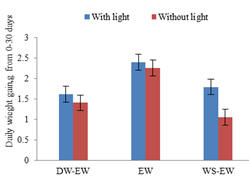 |
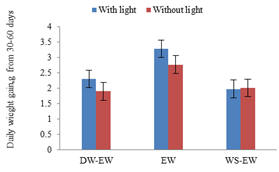 |
|
Figure 1:
Interaction between protein sources and with or without light
supplementation on growing frog (0-30 days) |
Figure 2:
Interaction between protein sources and with or without light
supplementation on growing frog (30-60 days) |
|
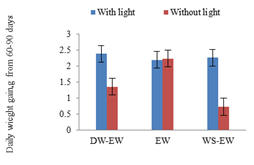 |
 |
|
Figure 3:
Interaction between protein sources and with or without light
supplementation on growing frog (60-90 days) |
Figure 4:
Interaction between protein sources and with or without light
supplementation on growing frog (0-90 days) |
Figure 5 showed that body
weight at starting to 20 days were not much changed but started from 30 days
toward, the daily weight gain were changed and highest for frog fed EW alone,
then DW-EW but the lowest in WS-EW. In term of light also showed that no
different at starting to 10 days but from 20 days toward the daily weight were
better for frog supplement light at night compared without light supplementation
(figure 6).
|
 |
 |
|
Figure 5:
Live weight gain of frog every 10 days |
Figure 6:
Live weight gain of frog every 10 days |
Feed
conversion ratio
In overall, feed conversion
ratio in DM basis was better for the mixture of DW-EW and EW alone and poorest
was WS-EW treatment (P<0.001), while the light supplementation was not effect
(P>0.05) but excepted period of 60-90 days, feed conversion ratio were better on
light supplementation (P<0.05). The DM feed conversion ratio (FCR) in this study
was higher than the study of Latsamy Phounvisouk and Preston (2007), the low FRC
might be cause of the amount of feed offer were controlled according to the
appetite of the frogs with the objective of avoiding feed residues, while in
present study amount of feed offer were fix at 10% of body weight because the
experiment was conducted in raining season and could not collect feed refusal.
There were no interaction between protein sources and light supplementation on
feed conversion ratio (P>0.05) but excepted from 60-90days which has interaction
effect (P=0.037).
|
Table 5:
Mean value of feed conversion ratio of frog fed earthworm (EW) or
duckweed mix with earth worm (DW-EW) or water spinach mix with
earthworm (WS-EW) with basal diet of rice bran and broken rice |
|
|
Protein sources |
Light
supplementation |
Interaction
|
|
DW-EW |
EW |
WS-EW |
SEM |
Prob |
With |
Without |
SEM |
Prob |
Prob |
|
Feed
conversion ratio, g feed/ g weight gain in DM basis |
|
|
|
|
|
|
0-30 days |
2.04a |
1.14a |
1.71b |
0.15 |
0.004 |
1.60 |
1.66 |
0.13 |
0.76 |
ns |
|
30-60 days |
3.97 |
3.01 |
3.41 |
0.31 |
0.129 |
3.65 |
3.28 |
0.25 |
0.31 |
ns |
|
60-90 days |
8.30 |
6.95 |
10.7 |
1.36 |
0.176 |
6.63 |
10.7 |
1.11 |
0.023 |
0.037 |
|
0-90 days |
4.34a |
3.33a |
4.06b |
0.15 |
0.001 |
3.81 |
4.01 |
0.12 |
0.254 |
ns |
|
abc
Means within main effects within rows without common letter are
different at P<0.05 |
Survival
rate
In table 6 showed that EW
treatment has highest survival rate rather than mixture of DW-EW and WS-EW
(P<0.05) but protein sources from forage (duckweed or water spinach) mix with
earthworm were not significant different, meanwhile, light supplementation at
night was effect on high survival rate compared with without light
supplementation (P<0.005). However, survival rate in present study was lower
than study of Latsamy Phounvisouk and Preston (2007) showed that the mortality
of frogs was 2.48-3.26% only. High mortality or low survival rate in this
present study might be some frogs escaped from ponds or ate by predators (snack)
because dead frogs could not find in the pond in the whole experiment. There
were no interaction between protein sources and light supplementation on
survival rate (P>0.05).
|
Table 6:
Survival rate of frog fed earthworm (EW) or duckweed mix with earth
worm (DWEW) or water spinach mix with earthworm (WSEW) with basal
diet of rice bran and broken rice |
|
|
Protein sources |
Light
supplementation |
Interaction
|
|
DW-EW |
EW |
WS-EW |
SEM |
Prob |
With |
Without |
SEM |
Prob |
Prob |
|
Total initial
frog |
8 |
8 |
8 |
- |
- |
8 |
8 |
- |
- |
- |
|
Total finale
frog |
6.17ab |
7.00a |
5.67b |
0.319 |
0.036 |
6.89 |
5.67 |
0.26 |
0.006 |
ns |
|
% survival rate |
77.1ab |
87.5a |
70.8b |
3.98 |
0.036 |
86.1 |
70.8 |
3.27 |
0.006 |
ns |
|
ns: Non
significant
ab
Means within main effects within rows without common letter are
different at P<0.05 |
Frog yield
In table 7 showed that total
initial frog weight was not different (P>0.05), but after 90 days of
experiments, total frog weight was increased (P<0.001) and net yield increase
per pond and net yield increase per ha were found high in EW treatment rather
than DW-EW and DW-EW (P<0.001), however, protein from forage mix with earthworm
was not significant different. Meanwhile, light supplementation effect on high
net yield compared with without light supplementation (P<0.001). The net
increase in live weight in present study was ranged from 143.6-225.5g in 90 days
and it was rang with study of Latsamy Phounvisouk and Preston (2007) (252 g in
90 days the frog eat earthworms plus duckweed) and Bounsong, (2001) (200g in 120
days that frog fed an artificial diet containing fish meal, dextrin, starch,
rice bran, vegetable oil, tuna oil, vitamins, minerals, BHT and Choline
chloride). There were no interaction between protein sources and light
supplementation on frog yields (P>0.05).
|
Table 7:
Mean value of yield of frog fed earthworm (EW) or duckweed mix with
earth worm (DWEW) or water spinach mix with earthworm (WSEW) with
basal diet of rice bran and broken rice |
|
|
Protein sources |
Light
supplementation |
Interaction
|
|
DW-EW |
EW |
WS-EW |
SEM |
Prob |
With |
Without |
SEM |
Prob |
Prob |
|
Total initial
weight, g |
202.7 |
152.3 |
125.3 |
24.9 |
0.125 |
175.4 |
144.8 |
20.3 |
0.308 |
ns |
|
Total finale
weight, g |
1169.3a |
1723.4b |
924.5a |
93.1 |
0.001 |
1545.0 |
999.8 |
76.0 |
0.001 |
ns |
|
Net yield
increase/pond, g |
966.6a |
1571.0b |
799.1a |
90.1 |
0.001 |
1369.5 |
854.9 |
73.6 |
0.001 |
ns |
|
Net yield
increase , kg/ha |
4832.8a |
7855.1b |
3996.7a |
450.7 |
0.001 |
6847.7 |
4274.7 |
367.9 |
0.001 |
ns |
|
ns: Non
significant
ab
Means within main effects within rows without common letter are
different at P<0.05 |
Water
quality parameter
The mean value of water
temperature was 26, 30 and 280C
in morning, afternoon and evening respectively, this value rang with
recommendation of Uodone (2004) that suitable temperature was 26.5 to 27.80C.
According to Diana et al., (1997) reported that water temperatures of 18o-22oC
are generally suitable for rearing larval salamander species found in Laos, and
temperatures of 18o-22oC are suitable for most species of
frog. In term of pH value was range from 6.14 to 7.28 which similar
recommendation from Uodone (2004) that ranged from 5.5-7.7. Dissolved oxygen was
found high for EW treatment (P<0.05) but not different between DW-EW and WS-EW,
meanwhile, DO in light supplementation was higher than without light
supplementation (P<0.05), however, this value was ranged with study of Uodone
(2004) (5.6-7.2).
|
Table 8:
Water quality parameter of frog fed earthworm (EW) or duckweed mix with
earth worm (DWEW) or water spinach mix with earthworm (WSEW) with basal
diet of rice bran and broken rice |
|
|
Protein sources |
Light
supplementation |
Interaction
|
|
DW-EW |
EW |
WS-EW |
SEM |
Prob |
With |
Without |
SEM |
Prob |
Prob |
|
Temperature,
0C |
|
|
|
|
|
|
|
|
|
|
Morning |
26.2 |
26.0 |
26.4 |
0.18 |
0.296 |
26.1 |
26.2 |
0.15 |
0.798 |
ns |
|
Afternoon |
30.4 |
30.2 |
30.3 |
0.62 |
0.960 |
30.2 |
30.3 |
0.51 |
0.940 |
ns |
|
Evening |
28.2 |
28.4 |
28.3 |
0.52 |
0.943 |
28.2 |
28.3 |
0.42 |
0.927 |
ns |
|
pH value |
|
|
|
|
|
|
|
|
|
|
|
Morning |
6.23ab |
6.14a |
6.35b |
0.04 |
0.004 |
6.27 |
6.21 |
0.03 |
0.198 |
ns |
|
Evening |
7.28 |
7.20 |
7.23 |
0.09 |
0.856 |
7.34 |
7.14 |
0.07 |
0.075 |
ns |
|
Dissolved
oxygen, mg/liter |
|
|
|
|
|
|
|
|
|
Morning |
4.83a |
6.33b |
4.67a |
0.33 |
0.007 |
5.44 |
5.11 |
0.27 |
0.403 |
ns |
|
Evening |
6.67 |
7.33 |
6.32 |
0.38 |
0.215 |
7.11 |
6.44 |
0.31 |
0.159 |
ns |
|
ns: Non
significant
ab
Means within main effects within rows without common letter are
different at P<0.05 |
Conclusions
- Through the experiment conducted in 90 days can concluded that growth
rates, survival and yield were best on treatment earthworm alone and light
supplementation, while the mixture of duckweed with earthworm were improved
but poorest was water spinach mix with earthworm. The net increase in live
weight was 225.3 on the best diet (earthworms) was better than in one report
concerning frogs fed an artificial diet (200 g in 120 days).
Acknowledgments
The authors would like to
express the gratitude to the MEKARN project financed by the SIDA-SAREC Agency.
Student from Preak Leap agriculture colleague for helping and take care the
experiment and Center for Livestock and Agriculture Development for providing
resources for conducting this experiment.
References
Akasay N 1994.
Frog culture for coomerce treade cooperate frog culture Thailand 10-20
AOAC 1990.
Official methods of Analysis. Association of Official Analytical Chemists. 15th
edition (k Helrick
editors). Arlington pp 1230
Bounsong V 2001.
The survey raising frog in 8 districts of Vientiane Municipality. Aquaculture
unit. Living Aquatic Resource Research Center. Page 30-35.
Bay N 2002.
Study of production and utilization of earth worm (perionyx excavatus) as feed
supplement in
chicken diets in order to improvescavenging
chicken production system at farmers’s level. Doctoral thesis.
Chhay Ty and Preston T R 2005a.
Effect of water spinach and fresh cassava leaves on intake, digestibility and N
retention in growing pings. Livestock Research for Rural Development. Vol. 17,
Art. #23. Retrieved June 30, 2005, from
http://www.cipav.org.co/lrrd/lrrd17/2/chha17023.htm
Chhay Ty and Preston T R 2005b.
Effect of water spinach and fresh cassava leaves on growth performance of pigs
fed a basal diet of brokne rice. Livestock Research for Rural Development. Vol.
17, Article #76. Retrieved Augurst 20, 2008, from
http://www.cipav.org.co/lrrd/lrrd17/7/chha17076.htm
Chhay Ty and Preston T R 2006. Effect
of different ratios of water spinach and fresh cassava leaves on growth of pigs
fed basal diets of broken rice or mixture of rice bran and cassava root meal.
Livestock Research for Rural Development. Volume 18, Article No. 57.
http://www.cipav.org.co/lrrd/lrrd18/4/chha18057.htm
Chhay Ty, Borin K and Preston T R 2007.
Effect of mixtures of water spinach and fresh water hyacinth leaves on growth
performance of pigs fed a basal diet of rice bran and cassava root meal.
Livestock Research for Rural Development.
Volume 19, Article #194. Retrieved
September 10, 2008, from
http://www.cipav.org.co/lrrd/lrrd19/12/chha19194.htm
Diana J S, Szyper J P, Batterson T R, Boyd C E and Piedrahita R H 1997
water quality in
Ponds. In: Egna, H., S, Boyd, C., E (Eds),
Dynamics of pond Aquaculture. CRC press LLC, New
York, pp.53
Guerro R D 1983.
The culture and use of Perionyx excavates as a protein resources in the
Philippines. In Earthworm Ecology from Darwin to vermin culture. Satchell
(Eds.), Chapman and Hall, London, 310
Kale R D, Bano K and Krishnamoorthy R V 1982.
Potential of Perionyx excavatus for utilizing organic wastes.
Pedobiologia, 23: 419-425.
LARReC 2001
Memorandum and frog survey in Vientiane
prefecture, Living Aquatic Resources Research Center, dated 9/4/02.
Latsamy Phounvisouk and Preston T R 2007.
Fly larvae, earthworms and duckweed as feeds for frogs in an integrated farming
system. MSc Thesis, MEKARN-SLU
http://www.mekarn.org/MSC2005-07/theses07/lats2.htm
Le Ha Chau 1998.
Biodigester effluent versus manure from pig or cattle as fertilizer for duckweed
(Lemna spp).
Leng R A, Stambolie J H and Bell R 1995.
Duckweed-a potential high protein feed resources for domestic animal and fish.
Livestock Research for Rural Development. 7(1): HTML format.
Lieng K, Phanousith S and Vongvichith B 2003.
Frog Breeding and Nursing from Frog nursing
in Cage by used different feed, faculty Agriculture, National University of
Laos. Page. 32.
Marttinez I P, Herrez M P and Alvalez R 1993.
Optimum Level of Dietary Protein for Rana
perezi Seane larvae. Aquaculture and
Fisheries Management.271-278 p.
Minitab 2007.
Minitab reference Manual release
15.1.2. User’s guide to statistics. Minitab Inc., USA
Muztar A J, Slinger S J and Burton J H 1976.
Nutritive value of aquatic plants for chicks. Poultry Science 55: 1917-1921.
Nguyen Duy Quynh Tram, Le Duc Ngoan and Ogle B 2007.
Effect of processing pig manure through a biodigester
as fertilizer for fish ponds on water quality and growth performance of three
fish species. Master thesis 2005-2007 http://www.mekarn.org/msc2003-05/theses05/tram_p1.pdf
Nguyen Van Lai and Rodriguez Lylian 1998.
Digestion and N metabolism in Mong Cai and Large White pigs having free access
to sugar cane juice or ensiled casssva root supplmented with duckweed or ensiled
cassava leaves. Livestock for Rural Development. (10) 2: (in HTML format).
Nguyen Duc Anh and Preston T R 1997.
Evaluation of portein quality in duckweed (Lemna spp) using a duckling growth
assay. Livestock for Rural Development. (9) 2: (In HTML format).
Rodriguez Lylian and Preston T R 1996.
Comparative parameters of digestion and N metabolism in Mong Caiand Mong Cai
Large White cross piglets having free access to sugar cane juice and duckweed.
Livestock for Rural Development. (8) 1: 72-81
Rodriquez-Serna M A, Flores-Nava M A, Olvera-Nova C and Carmona-Osalde
1996
Growth and production of bull frogs, Rana catesbiana Shaw, 1802, at 3 stocking
densities in a vertical intensive culture system. Aqua cultural Engineering 15:
233-242.
Rusoff L L, Blakeney W W and Culley D D 1980
Duckweed (Lemnaceac Family): A potential source of protein and amino acids.
Journal of Agriculture and Food Chemistry. 28:848-50
Somsueb P and Boonyaratpalin M 2001.
Optimum protein and energy levels for the Thai native frog, Rana
rugulosa
Weigmann. Aquaculture Research 32, 33-38.
Thongyount T 2004.
Reported Frog Processing and Frog
Culture, Faculty of Fisheries
Latsmongkhon Technology Institute. 10-35 p. Natural and Semi artificial, Living
Aquatic Resource Research Center,
National Agriculture and forestry Research Institute, Ministry of
Agriculture and forestry. Page 15-30.
Uodone 2004.
Frog hatchery on training course in Vientiane city, Laos. Page 12.
Undersander D, Mertens D R and Theix N 1993.
Forages analyziz procedures. National Forages Testing Association. Omaha pp 154
Go to top











